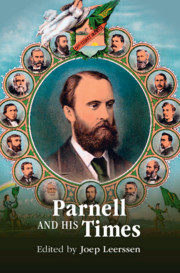Book contents
- Parnell and His Times
- Frontispiece
- Parnell and His Times
- Copyright page
- Dedication
- Contents
- Illustrations
- Contributors
- Acknowledgement
- Introduction
- Part I Parnell’s Ireland and Its Different Temporalities
- Part II After Parnell
- Chapter 9 Parnell and James Joyce’s Dubliners
- Chapter 10 ‘The Rhythm of Beauty’
- Chapter 11 ‘Ingenious Lovely Things’
- Chapter 12 Modernism in the Streets
- Chapter 13 Modernism, Belfast, and Early Twentieth-Century Ireland
- Chapter 14 Too Rough for Verse?
- Chapter 15 ‘Myth, Fact and Mystery’
- Chapter 16 The ‘Easter Rising’
- Chapter 17 Late Style Irish Style
- Index
Chapter 11 - ‘Ingenious Lovely Things’
Yeats’s Adjectives
from Part II - After Parnell
Published online by Cambridge University Press: 03 December 2020
- Parnell and His Times
- Frontispiece
- Parnell and His Times
- Copyright page
- Dedication
- Contents
- Illustrations
- Contributors
- Acknowledgement
- Introduction
- Part I Parnell’s Ireland and Its Different Temporalities
- Part II After Parnell
- Chapter 9 Parnell and James Joyce’s Dubliners
- Chapter 10 ‘The Rhythm of Beauty’
- Chapter 11 ‘Ingenious Lovely Things’
- Chapter 12 Modernism in the Streets
- Chapter 13 Modernism, Belfast, and Early Twentieth-Century Ireland
- Chapter 14 Too Rough for Verse?
- Chapter 15 ‘Myth, Fact and Mystery’
- Chapter 16 The ‘Easter Rising’
- Chapter 17 Late Style Irish Style
- Index
Summary
One of the most significant moves by Yeats in creating his late style is a new form of adjectival description. It uses a sequence of (often complex, often anomalous) adjectives to describe a single phenomenon, e.g., ‘That dolphin-torn, that gong-tormented sea’. These sequences provoke us to understand the thought process that creates each of the adjectives: How can a sea be ‘torn’? How can a sea be ‘tormented’ by a gong? (These are new aspects of the sea ‘of mire and blood’: ‘torn’ makes it a wounded body, ‘tormented’ makes it a wounded soul.) The two agents – dolphin and gong – are likewise redefined. Instead of being merely the bearers of souls, the dolphins become cruelly aggressive goads to the reluctant body, forcing it towards Byzantium, and the gong, instead of being merely an indicator of midnight, becomes a last call of impending physical death. I begin with early ‘simple’ single adjectives (‘lovely’, ‘dim’), often used repetitively, and then consider the later adjectives, offering many perspectives at once, turning the reader’s gaze from aspect to aspect. An altogether higher order of intellectuality generates these, requiring intense attempts to follow the successive aspects being identified.
- Type
- Chapter
- Information
- Parnell and his Times , pp. 199 - 218Publisher: Cambridge University PressPrint publication year: 2020

